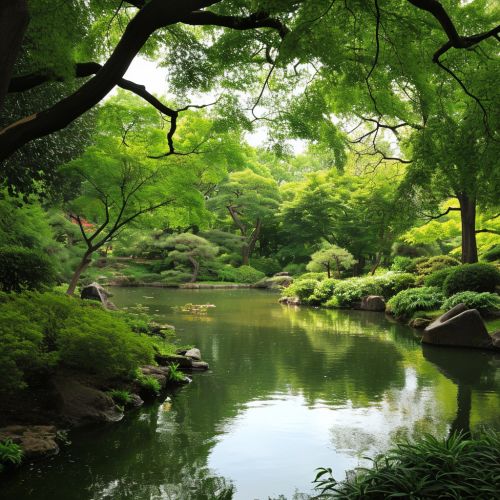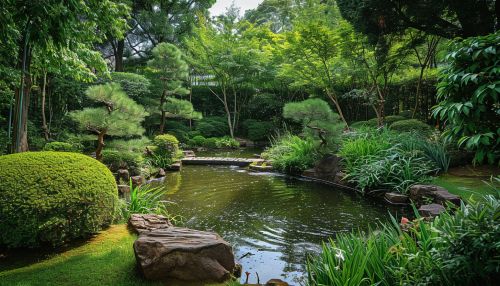Japanese garden
Overview
The Japanese garden is a traditional style of garden in Japan that has evolved over centuries, influenced by Shinto, Buddhist, and Taoist philosophies. These gardens are designed to inspire reflection and meditation, often incorporating elements of miniaturization, concealment, and borrowed scenery.
History
Japanese gardens have a long history, dating back to the Asuka period (538-710 AD), when Japanese gardening techniques were heavily influenced by Chinese and Korean gardening practices. The gardens of this era often featured ponds and islands, inspired by the Buddhist concept of paradise.


During the Heian period (794-1185 AD), the style of Japanese gardens began to evolve, with a greater emphasis on aesthetics and the use of gardens as settings for courtly life. The gardens of this era often featured large ponds with islands and bridges, and were designed to be viewed from a boat.
The Kamakura and Muromachi periods (1185-1573 AD) saw the development of the Zen garden, or karesansui. These gardens were designed for contemplation and meditation, and often featured rock formations, gravel, and sand, but no water.
During the Edo period (1603-1868 AD), Japanese gardens became more elaborate and ornate, with a greater emphasis on aesthetics. The gardens of this era often featured tea houses and large ponds, and were designed to be viewed from a specific vantage point.
In the modern era, Japanese gardens have continued to evolve, with a greater emphasis on naturalism and simplicity. These gardens often feature elements of both traditional Japanese and Western gardening techniques.
Design Principles
The design of Japanese gardens is guided by a set of principles that aim to create a harmonious and tranquil space. These principles include miniaturization, concealment, borrowed scenery, asymmetry, and balance.
Miniaturization
Miniaturization is a key principle in Japanese garden design. This involves the use of small-scale elements to represent larger natural landscapes. For example, a small pond may represent a large lake, or a rock formation may represent a mountain range.
Concealment
Concealment is another important principle in Japanese garden design. This involves the use of elements such as fences, gates, and vegetation to create a sense of mystery and encourage exploration.
Borrowed Scenery
Borrowed scenery, or shakkei, is a technique in Japanese garden design where the surrounding landscape is incorporated into the design of the garden. This can include views of distant mountains, trees, or buildings.
Asymmetry
Asymmetry is a common feature in Japanese garden design. This involves the use of irregular shapes and forms to create a natural and harmonious look.
Balance
Balance is a key principle in Japanese garden design. This involves the careful placement of elements to create a sense of equilibrium and harmony.
Elements
Japanese gardens often incorporate a variety of elements, including water, rocks, vegetation, and structures.
Water
Water is a key element in Japanese gardens, often represented by ponds, streams, or waterfalls. Water is considered a symbol of purity and renewal in Japanese culture.
Rocks
Rocks are another important element in Japanese gardens. They are often used to represent mountains, islands, or other natural features.
Vegetation
Vegetation is a key element in Japanese gardens, often used to create a sense of enclosure and provide color and texture. Commonly used plants include pine, bamboo, cherry blossoms, and azaleas.
Structures
Structures such as tea houses, bridges, and gates are often incorporated into Japanese gardens. These structures are often designed to blend in with the natural environment.
Styles
There are several distinct styles of Japanese gardens, including the pond garden, the dry landscape garden, the tea garden, and the stroll garden.
Pond Garden
The pond garden, or chisen-shoyū-teien, is a style of Japanese garden that features a large pond as its central element. The pond is often surrounded by a variety of plants and rocks, and may include islands and bridges.
Dry Landscape Garden
The dry landscape garden, or karesansui, is a style of Japanese garden that uses rocks, gravel, and sand to represent water and other natural features. This style of garden is often associated with Zen Buddhism and is designed for contemplation and meditation.
Tea Garden
The tea garden, or roji, is a style of Japanese garden that is designed as a setting for the Japanese tea ceremony. It often features a rustic tea house and a path leading to it, lined with stepping stones.
Stroll Garden
The stroll garden, or kaiyū-shiki-teien, is a style of Japanese garden that is designed to be viewed from a path that winds through the garden. The path often leads past a variety of scenes and vistas, each carefully composed to create a specific mood or atmosphere.
Maintenance
Maintaining a Japanese garden requires careful attention to detail and a deep understanding of the principles of Japanese garden design. This often involves regular pruning, weeding, and cleaning, as well as periodic replacement of plants and rocks.
Influence
Japanese gardens have had a significant influence on the development of garden design around the world. They have inspired a number of Western garden styles, including the English landscape garden and the modernist garden.
